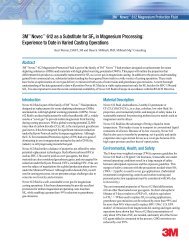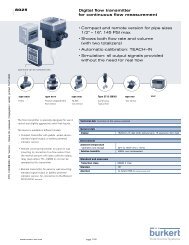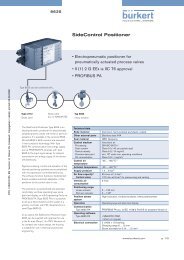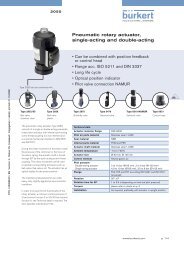Solenoid valves - Bürkert Fluid Control Systems
Solenoid valves - Bürkert Fluid Control Systems
Solenoid valves - Bürkert Fluid Control Systems
Create successful ePaper yourself
Turn your PDF publications into a flip-book with our unique Google optimized e-Paper software.
3.4.<br />
Opening and closing<br />
operations in pipes<br />
with fluids<br />
p R<br />
Pressure waves<br />
a<br />
a<br />
Valve upstream pressure<br />
p R bei w = 0<br />
p F bei w 1<br />
3.4.1. Origination and propagation<br />
of pressure waves<br />
If the velocity of a fluid stream in a pipe<br />
changes as the result of opening or<br />
closing a valve, it results in a conversion<br />
of the kinetic energy of the fluid<br />
into a pressure wave which is propagated<br />
from the valve at the propagation<br />
speed “a” of the flow medium against<br />
the flow direction (Figure 11), until<br />
reaching the tank or vessel outlet<br />
(deflection point) where it is reflected<br />
again, etc. This results in pressure undershoots<br />
and overshoots which are<br />
referred to as suction surges and<br />
pressure surges or “water hammer<br />
phenomena”.<br />
In the case of compressible fluids, the<br />
propagation speed “a” of pressure<br />
and velocity changes is equal to the<br />
speed of sound a in the medium in<br />
question.<br />
Speed of sound “a” for fluids in thickwalled,<br />
rigid pipes:<br />
Where:<br />
E: Modulus of elasticity of the<br />
medium in N/m 2<br />
: Density of the medium.<br />
w 0<br />
w 1<br />
L<br />
Figure 11:<br />
Basic mechanical construction of a simple pipe run system<br />
a =<br />
E<br />
<br />
[m/s]<br />
Speed of sound “a” for fluids in thinwalled,<br />
flexible pipes:<br />
E F 1<br />
a = · [m/s]<br />
1+ D·E F<br />
S·E R<br />
w 0<br />
w 1<br />
Unobstracted outlet<br />
The following approximate values can<br />
be assumed for the speed of propagation<br />
or speed of sound in water:<br />
Thick-walled metal pipes: a ≈ 1300 m/s<br />
Thin-walled pipes: a ≈ 1000 m/s.<br />
Equation 10<br />
Where:<br />
D: Pipe diameter<br />
S: Wall thickness<br />
E F : Modulus of elasticity of the<br />
fluid<br />
E R : Modulus of elasticity of the<br />
pipe material.<br />
32/33








